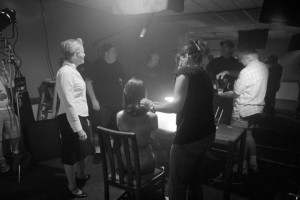And so it begins…
With story concept well underway I left the brainstorm session to get some sleep. Being through this process before I knew that Friday night would be my last chance at a full nights sleep until this iron man version of filmmaking was over. I fell into dreamland with the visions of a knockout 1940’s looking fem fetal who was lifting a cheek to squeeze one out.
Saturday morning, The script arrives
I awoke in the morning to check my email and read the script that the writer, Marianne Bates, had worked on all night. Although I was still uneasy about the flatulence part of the equation there were some laugh out loud moments while reading. The script was complete with the hard boiled slang that is to be expected from any self respecting film noir project. After a few hours of gathering music and sound effects that would be needed I headed down to the first location to start importing the footage.
The DSLR workflow
I arrived on set and started getting footage from the camera crew. The film was being shot entirely on DSLR cameras so there was a bit of a challenge to post production. When working with these cameras you need to shoot audio on a separate device since the on camera audio is far from usable. Luckily we had an amazing location sound crew that gave me all the separate tracks plus a mix channel that was being mixed on the fly. For the most part this allowed me to use just that mix track which saved a lot of time in post. I set up the portable editing suite and started importing and syncing image to sound.
Here’s a quick tip for you. If you’re going to do a DSLR workflow I would suggest having an assistant editor on the project to sync footage for you while you edit. Not because you’re “The Editor” and this work is below you, but because it will save you time and allow you to concentrate on the cut. I did not have an assitant so it was up to me to do it all.
When I had caught up to the crew on importing the footage I had an idea for the murder scene in the film that was being shot by the second unit. I asked the 2nd unit director, Christopher Francis, to get me some shots that I wanted in the scene to build some tension. I asked for closeups on hands, faces etc… and boy did he deliver.
Back to the edit bay
When I was out of things to do on location I headed back to the shop to start cutting things in the edit bay. This was the first time I pulled the color from the shots and started looking at the images in black and white. I immediately knew that if nothing else, this would be a beautifully shot film. I have heard is said that the measure of the cinematography in a film is if you can stop on any frame and then hang that frame on the wall as a piece of art. This film achieved that in my opinion.
I decided that instead of cutting the film on one timeline I would split it into scenes and cut each scene as it’s own entity. This was both a good and bad idea. On the good side it allowed me to let each scene tell it’s own story, sort of like a chapter in a book. The down side will come a little later, I don’t want to still the beans (pun intended) just yet.
More footage arrives
A I was happily editing away when more footage arrived at the edit bay. I stopped editing and began importing that footage. Remember what I said about having an assistant? This was where I really needed it. Nothing like stopping the creative flow to start doing technical stuff. This footage contained the scene in the interrogation room and when I started cutting the segment where the female detective, Theresa Lane, is interrogating the female lead, Cristyn Chandler, I had limited coverage on it. I basically had a wide shot and a closeup, both 2 person shots. I had no closeups as singles on either actor. This turned out to be a very happy accident.
Unknown to me the closeup single shots were still on a card that was in one of the cameras on location. Not knowing this I assumed that the coverage I had for this scene was the wide and closeup 2 shots, nothing more. So I worked with what I had. The scene transitions from wide to close to break up that action. I had my doubts on if this would work, but after I roughed in the shots, it worked amazingly well. In the scene there is tension that builds between that characters and this not traditional, maybe even a little odd, juxtaposition of the shots added to the tension. The difference in framing was enough to make it not quite a jump cut, but enough to make it feel a little… tense.
At this point I had all but the last scene cut and that footage was on the way from the last location as the crew was wrapping. Little did I know I was in for a interesting little musical surprise…


